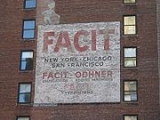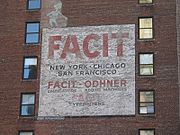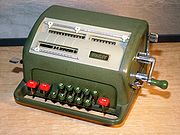
Facit
Encyclopedia


Åtvidaberg
Åtvidaberg is a locality and the seat of Åtvidaberg Municipality, Östergötland County, Sweden with 6,947 inhabitants in 2005.- History :...
, Sweden
Sweden
Sweden , officially the Kingdom of Sweden , is a Nordic country on the Scandinavian Peninsula in Northern Europe. Sweden borders with Norway and Finland and is connected to Denmark by a bridge-tunnel across the Öresund....
, and founded in 1922 as AB Åtvidabergs Industrier. Facit AB, a manufacturer of mechanical calculators, was incorporated into the corporation the same year. In 1932, the first ten-digit calculator was manufactured by Åtvidaberg Industries, it was named FACIT and became a great success.
By the early 1960s the corporation had a total of 8,000 employees with subsidiaries in over 100 countries, and the subsidiary Facit had come to dominate the business of the corporation. In 1965 the entire corporation changed its name to Facit AB. The following year, it acquired its competitor Addo
AB Addo
AB Addo was a former Swedish engineering company which manufactured office machines. The company, based in Malmö, was founded in 1918. In 1966 it was incorporated into Facit, where it remained as a subsidiary until the early 1980s. Its products consisted mainly of adding machines, calculators,...
, which was maintained as a separate subsidiary. Under the popular leadership of Gunnar Ericsson
Gunnar Ericsson
Gunnar Lennart Vilhelm Ericsson is a Swedish businessman, sports official and Liberal Party politician. He was born in Stockholm....
, Facit focused increasingly on its mechanical calculators, branding, marketing and global expansion. This strategy was referred to as "The New Deal". Throughout the 1960s Facit experienced an increased growth and a high profitability.
However, electronic calculators were rapidly improving in performance and gained larger market shares over time. In 1965, 4000 digital calculators were sold globally. The next year, the same figure had reached 25 000 and in 1967 they accounted for 15 percent of the market.
Facit sought to handle this disruptive threat by collaborating with the Japanese firm Hayakawa (Sharp
Sharp Corporation
is a Japanese multinational corporation that designs and manufactures electronic products. Headquartered in Abeno-ku, Osaka, Japan, Sharp employs more than 55,580 people worldwide as of June 2011. The company was founded in September 1912 and takes its name from one of its founder's first...
). The electronic calculators were manufactured in Japan and during 1965-67 Facit had exclusive rights to sell them through its global market organization under the Facit brand. As Hayakawa started to build its own global sales organization, the relationship between the two companies became increasingly strained.
In 1970, the company had reached the peak of its growth, with more than 14,000 employees worldwide. In 1971, modern Japanese-made calculators started to seriously disrupt the industry, instantly making the mechanical calculators manufactured by Facit obsolete. As a result, Facit went out of business virtually over-night. The general view on this failure is that Facit met its demise as a result of refusing to acknowledge the superiority of modern calculators, as well as an unwillingness to adapt and change accordingly, to meet the new demands from the market. Other reasons for this have been mentioned as well: for instance the inability to consolidate the R&D functions of acquired companies as well as limited R&D resources due to the relatively small size of Facit compared to its American counterparts.
Facit was sold to Electrolux
Electrolux
The Electrolux Group is a Swedish appliance maker.As of 2010 the 2nd largest home appliance manufacturer in the world after Whirlpool, its products sell under a variety of brand names including its own and are primarily major appliances and vacuum cleaners...
in 1973. In 1983 it was again sold to Ericsson
Ericsson
Ericsson , one of Sweden's largest companies, is a provider of telecommunication and data communication systems, and related services, covering a range of technologies, including especially mobile networks...
, whereby an attempt to manufacture microcomputer
Microcomputer
A microcomputer is a computer with a microprocessor as its central processing unit. They are physically small compared to mainframe and minicomputers...
s was initiated. During 4 years, the Facit home computer became popular in Sweden. It offered some innovative solutions with a version of BASIC
BASIC
BASIC is a family of general-purpose, high-level programming languages whose design philosophy emphasizes ease of use - the name is an acronym from Beginner's All-purpose Symbolic Instruction Code....
as a programming language
Programming language
A programming language is an artificial language designed to communicate instructions to a machine, particularly a computer. Programming languages can be used to create programs that control the behavior of a machine and/or to express algorithms precisely....
. However, as this venture didn't turn out to be a profitable one, it was terminated in 1988.
The company was subsequently divided between foreign owners. The remainder of the corporation known as Facit AB was finally terminated in 1998.

